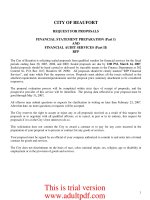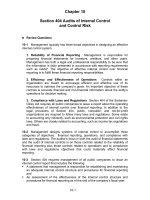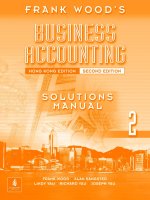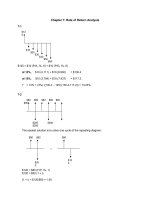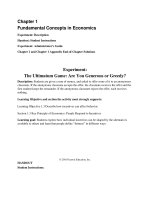Chapter 10 solutions 5th edition - Solution manual of Business Analysis & Valuation Using financial statement.
Bạn đang xem bản rút gọn của tài liệu. Xem và tải ngay bản đầy đủ của tài liệu tại đây (78.73 KB, 6 trang )
Chapter 10
Chapter 10
Credit Analysis and Distress Prediction
Discussion Questions
•
•
•
•
•
•
•
1. Financial analysts typically measure financial leverage as the ratio of debt to equity. However, there is
less agreement on how to measure debt, or even equity. How would you treat the following items in
computing this ratio? Justify your answers.
Revolving credit agreement with bank
Cash and marketable securities
Operating leases
Unrecorded pension commitments
Deferred tax liabilities
Preferred stock
Convertible debt
Revolving credit agreement with bank allows the company to borrow up to a certain amount (line
of credit) at an interest rate determined at the time of the agreement. The borrower pays interest on
the amount borrowed and interest of about 0.5 percent on the amount unused. Since the borrower
can convert the credit to straight debt, the used line of credit may be treated as debt.
Cash and marketable securities can be considered as negative leverages. Having high cash and
marketable securities has an effect on the company opposite to financial leverage. For example, a
high cash balance decreases the likelihood of financial distress.
Operating leases can be used to finance the right to use an asset for a fixed period. The question of
whether this is effectively debt and should be included in debt ratios depends on the nature of the
lease. For example, if a firm leased a car for six months, it would probably not be considered
effective debt. But if an airline company signed a multi-year operating lease for planes instead of
purchasing the aircraft outright with a bank loan, it does make sense to treat the present value of the
future operating lease payments as equivalent to debt. Recall, that under accounting rules, some
multi-year leases are recorded as capital leases and are classified as debt. Operating leases do not
qualify as debt for accounting purposes, but may nonetheless have many of the same features as
debt. Indeed, it appears that some firms specifically specify the terms in a lease contract to make
sure that it will not be classified as a capital lease, even though it has all of the characteristics of a
debt commitment.
© 2013 Cengage Learning. All Rights Reserved. May not be scanned, copied or duplicated, or posted to a publicly accessible website,
in whole or in part.
2 Instructor’s Manual
Unrecorded pension commitments are effective debt commitments. The firm has agreed to fund
pension obligations to its employees in the future. However, these have not yet been recognized in
the firm’s financial statements. Under SFAS 158 US firms are required to include the full unfunded
pension obligation as a liability on the balance sheet. But under the former US rules, increases in
commitments or changes in funding status from changes in the market value of the pension plan
assets would not be recognized immediately, giving rise to an unrecorded pension commitment.
Deferred tax liabilities represent the increase in taxes payable in future years as a result of taxable
temporary differences between financial accounting and tax accounting existing at the end of the
current year. For mature firms or declining firms, deferred tax liabilities can be treated as an
interest-free debt from the government (Internal Revenue Service) that may be repaid in the near
future. However, for rapidly growing firms, deferred taxes are unlikely to reverse any time soon,
making it more like equity.
Preferred stock may be treated as equity. Despite the fact that preferred stock offers a fixed
dividend like debt, the payment of dividend depends on management’s discretion. When the
company is seriously short of cash, management can decide to pay the preferred stock dividend in
the next period. Like common stock, preferred stock does not have a final principal payment date.
Also, preferred stockholders cannot force the company that skipped dividends to bankruptcy.
Convertible debt gives its owner the option to exchange the bond for a predetermined number of
common shares at a fixed price. When the convertible debt holders decide to exercise their option to
buy common stock, they just exchange the convertible debt with common stock. Convertible debt is
treated as debt until it is converted to common stock.
2. U.S. public companies with “low” leverage have an interest-bearing net debt-to-equity ratio of 0 percent
or less, firms with “medium” leverage have a ratio between 1 and 62 percent, and “high” leverage firms
have a ratio of 63 percent or more. Given these data, how would you classify the following firms in terms
of their optimal debt-to-equity ratio (high, medium, or low)?
•
•
•
•
•
a successful pharmaceutical company
an electric utility
a manufacturer of consumer durables
a commercial bank
a start-up software company
Successful pharmaceutical company. Low debt-to-equity ratio. A pharmaceutical company’s
business risks are relatively high and its assets can be easily destroyed by financial distress. Note
that the major assets of a pharmaceutical company are human capital and R&D intangibles.
Electric utility. High debt-to-equity ratio. Debt is a favorable financing for an electric utility
company, because an electric utility company has low business risks. An electric company’s
© 2013 Cengage Learning. All Rights Reserved. May not be scanned, copied or duplicated, or posted to a publicly accessible website,
in whole or in part.
Chapter 10 Credit Analysis and Distress Prediction 3
revenues and earnings are not sensitive to the fluctuations in the economy. In addition, an electric
utility company typically has large tangible assets to provide security for lenders.
Manufacturer of consumer durables. Medium debt-to-equity ratio. A manufacturer of consumer
durables is faced with medium level competition. Its main assets include equipment (tangible
assets) and technology (intangible assets); the cost of financial distress is medium.
Commercial bank. High debt-to-equity ratio. Commercial banks have a high proportion of liquid
assets. Further deposit insurance reduces depositors’ risk.
Start-up software company. Low debt-to-equity ratio. A start-up software company’s business risks,
similar to that of a pharmaceutical company, are relatively high and its assets can be easily
destroyed by financial distress.
3. What are the critical performance dimensions for (a) a retailer and (b) a financial services company
that should be considered in credit analysis? What ratios would you suggest looking at for each of these
dimensions?
The critical performance dimensions of a retailer are related to its inventory turnover and profit
margins. Inventory turnover ratio is the cost of goods sold divided by average inventory balance.
One measure of margins is net income divided by sales.
The critical performance of a financial services company includes the quality of assets (e.g., default
risks of loan portfolio), duration matching between assets and liabilities (i.e., its risk to interest rate
change), and profitability. The quality of loans that financial institution holds can be measured as
bad debt allowance divided by loans outstanding. Risk exposure can be measured by comparing the
duration between assets and liabilities. Profitability can be measured as net income divided by net
worth.
4. Why would a company pay to have its public debt rated by a major rating agency (such as Moody’s or
Standard and Poor’s)? Why might a firm decide not to have its debt rated?
The public debt rating influences the yield that must be offered to sell the debt instrument. Suppose
that a company has information that is favorable in borrowing but confidential. It would disclose the
confidential information to the rating agency on the condition that its confidentiality is maintained.
The rating agency can work as an intermediary that will close the information gap between the
company and public investors. A rating agency with credibility may help a company to get low cost
financing.
Since debt rating can be used as a mechanism to monitor management performance,
corporate managers may not want debt rating, which is another monitoring tool. Since the
© 2013 Cengage Learning. All Rights Reserved. May not be scanned, copied or duplicated, or posted to a publicly accessible website,
in whole or in part.
4 Instructor’s Manual
downgrades of debt rating are greeted with drops in both bond and stock prices, both debt holders
and shareholders will question corporate managers’ performance in cases of downgrades.
5. Some have argued that the market for original-issue junk bonds developed in the late 1970s as a result
of a failure in the rating process. Proponents of this argument suggest that rating agencies rated
companies too harshly at the low end of the rating scale, denying investment grade status to some
deserving companies. What are proponents of this argument effectively assuming were the incentives of
rating agencies? What economic forces could give rise to this incentive?
Proponents of this argument are assuming that rating agencies are more likely to be conservative,
because the cost of incorrect rating is asymmetrically severe if the investment-grade firms go
bankrupt. There are two types of errors in the rating decision: (1) rating below investment-grade
when the firm is healthy, and (2) rating investment-grade when the firm is not healthy (i.e., defaults
in the future). Since the latter type of error is more damaging to the rating agency’s reputation,
proponents of this argument would feel that the bond rating is likely to be conservative.
Commercial banks and many pension funds are allowed to invest only in investment-grade (a rating
of BBB or higher) bonds. Shareholders of commercial banks and the ultimate owners of pension
funds, who worry about fund managers’ risky investment decisions but cannot monitor the fund
managers’ day-to-day investment decisions, may want bond rating agencies to be conservative in
their investment-grade ratings. However, as seen in the financial crisis of 2008 and the high level of
defaults on supposedly top rated financial instruments, it seems that this has not always proven to be
the case.
6. Many debt agreements require borrowers to obtain the permission of the lender before undertaking a
major acquisition or asset sale. Why would the lender want to include this type of restriction?
When the firm is in financial difficulty, conflicts may arise between debtors and stockholders.
Managers who are likely to represent stockholders’ interest may invest in riskier assets. Since the
stock has an option value, a major acquisition of risky assets under financial distress can increase
the value of stock but decrease the value of debt. To protect against the possibility of increased
business risk, lenders establish debt covenants that borrowers obtain permission of the lender before
making a major acquisition. Asset sales potentially reduce the security lenders have in the case of
financial distress.
7. Betty Li, the CFO of a company applying for a new loan, states, “I will never agree to a debt covenant
that restricts my ability to pay dividends to my shareholders because it reduces shareholder wealth.” Do
you agree with this argument?
Betty argues that restricting the flexibility of management decisions (such as dividend payout
decisions) would reduce the shareholder wealth. However, if the dividend payout decisions are not
restricted, management (or other agents of the shareholders) can liquidate the company by paying
© 2013 Cengage Learning. All Rights Reserved. May not be scanned, copied or duplicated, or posted to a publicly accessible website,
in whole or in part.
Chapter 10 Credit Analysis and Distress Prediction 5
cash dividends to shareholders in the case of financial distress. Unless there is a restriction on
dividend payout, rational lenders, concerned about the liquidation of the firm through cash
dividend, will demand higher interest rates. Contrary to Betty’s argument, shareholder wealth is
reduced when there is no restriction on dividend payout, because no restriction would result in a
higher cost of borrowing.
8. Cambridge Construction Company follows the percentage-of-completion method for reporting longterm contract revenues. The percentage of completion is based on the cost of materials shipped to the
project site as a percentage of total expected material costs. Cambridge’s major debt agreement includes
restrictions on net worth, interest coverage, and minimum working capital requirements. A leading
analyst claims that “the company is buying its way out of these covenants by spending cash and buying
materials, even when they are not needed.” Explain how this might be possible.
Under the revenue recognition method of Cambridge Construction Company, the company can
accelerate revenue (and net income) recognition by purchasing materials. Suppose that the company
purchased $70 of raw materials when its cost of goods sold is 70% of sales (or the gross margin of
long-term contract is 30%) and its profit margin is 10%. The accounting journal entries for this
purchasing transaction are as follows:
1. Inventory and Accounts payable increase by 70%.
2. Accounts receivable and Sales increase by $100 (= $70/0.7). Inventory decreases by $70 and
Cost of goods increases by $70; other expenses increase by $20 and Accounts payable increases
by $20.
3. Net income and Net worth (retained earnings) both increase by $10 (= $100 ∞ 0.1).
Under the Cambridge Construction Company’s accounting policy, the $70 purchase of materials
increases net worth (retained earnings) by $10 and increases the interest coverage ratio by boosting
up the EBIT (numerator in ratio). It also helps the company to meet the minimum working capital
requirement by increasing net working capital by $10 or more. Note that current assets (accounts
receivable) increased by $100 whereas current liabilities increased by $90.
9. Can Cambridge improve its Z-score by behaving as the analyst claims in Question 8? Is this change
consistent with economic reality?
Cambridge can improve its Z-score by accelerating revenue recognition even if this change is not
consistent with economic reality. Accounting choice in Question 8 positively influences all of the
five components of the Altman Z-score: net working capital/total assets; retained earnings/total
assets; EBIT/total assets; shareholders’ equity/total liabilities; sales/total assets. Question 8 shows
why accounting analysis is important in credit analysis and distress prediction. Purely quantitative
models, such as the Altman Z-score, cannot substitute for the hard work of financial analysis
(business strategy analysis, accounting analysis, financial analysis, and prospective analysis).
© 2013 Cengage Learning. All Rights Reserved. May not be scanned, copied or duplicated, or posted to a publicly accessible website,
in whole or in part.
6 Instructor’s Manual
10. A banker asserts, “I avoid lending to companies with negative cash from operations because they are
too risky.” Is this a sensible lending policy?
No. A banker should decide whether the borrowing firm has the ability to service the debt at the
scheduled rate. Current period negative cash flow from operations is one of the factors that the
banker needs to consider but it is not the only factor. A banker should ask the following questions:
•
Can the company turn around its cash flows in future periods? If the company can generate
positive cash flow from operations in the future, lending to that company may not be risky.
•
Can the bank secure the loan with sufficient collateral in lending to the company? When the
amount of available security is sufficient to support the loan, the bank can minimize the risk of
loss in case of default.
•
Is there any third-party loan guarantee? If the borrower is the subsidiary and the parent presents
some financial strength independent of the subsidiary, a guarantee of the parent will reduce the
risk of loss.
11. A leading retailer finds itself in a financial bind. It doesn’t have sufficient cash flow from operations
to finance its growth, and it is close to violating the maximum debt-to-assets ratio allowed by its
covenants. The Vice-President for Marketing suggests, “We can raise cash for our growth by selling the
existing stores and leasing them back. This source of financing is cheap, since it avoids violating either
the debt-to-assets or interest coverage ratios in our covenants.” Do you agree with his analysis? Why or
why not? As the firm’s banker, how would you view this arrangement?
No, for several reasons. First, depending on the terms of the lease, accounting rules may ensure that
there is no material change in the retailer’s debt ratio or coverage ratio. This will happen if the lease
is recorded as a capital lease. Second, an operating lease arrangement may allow the company to
reduce the debt, but it will also reduce the asset base. Therefore, the banker may find the firm to be
more risky.
© 2013 Cengage Learning. All Rights Reserved. May not be scanned, copied or duplicated, or posted to a publicly accessible website,
in whole or in part.
